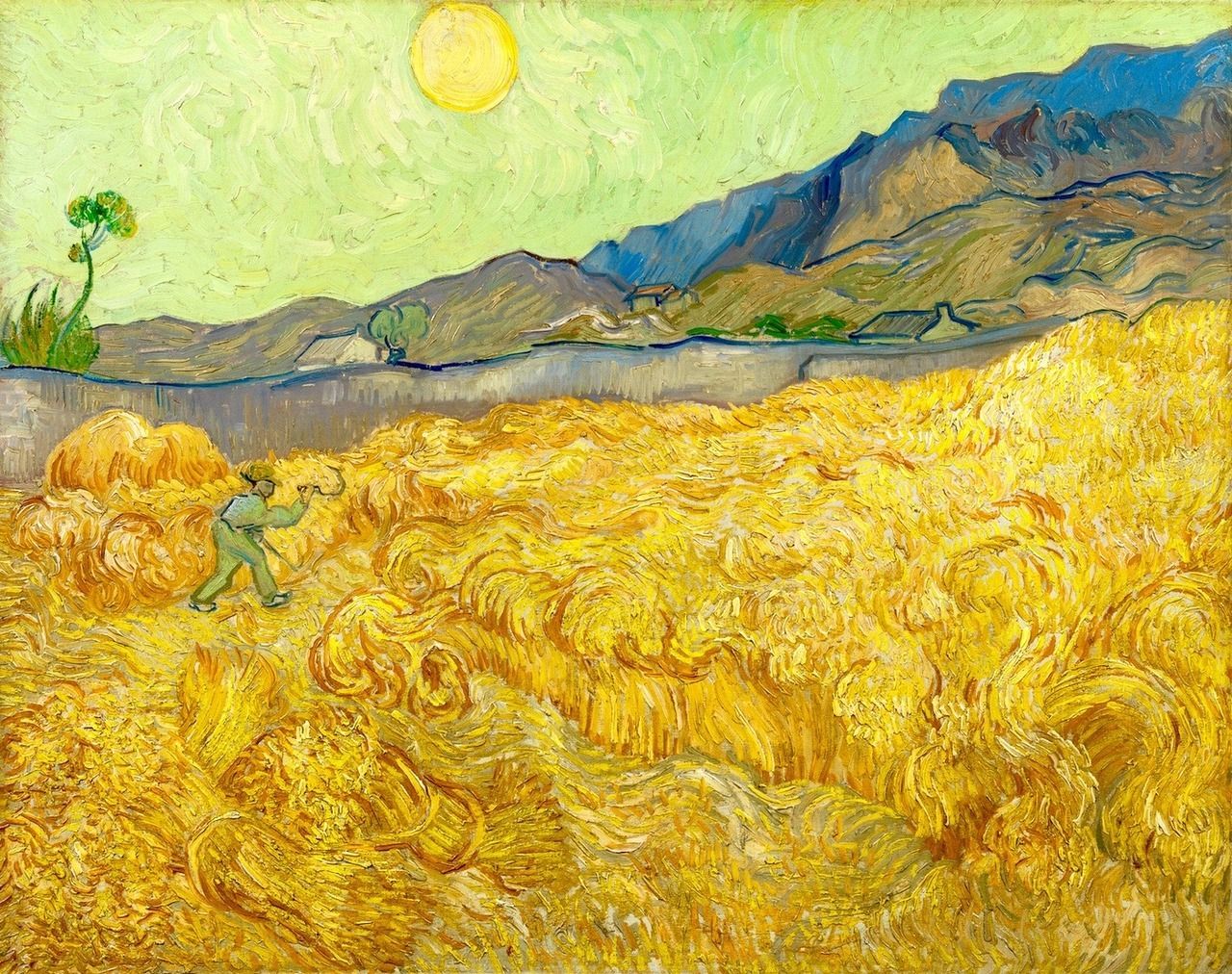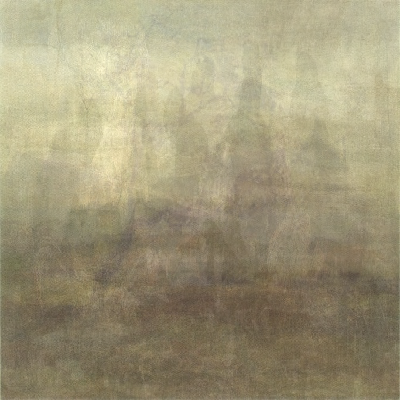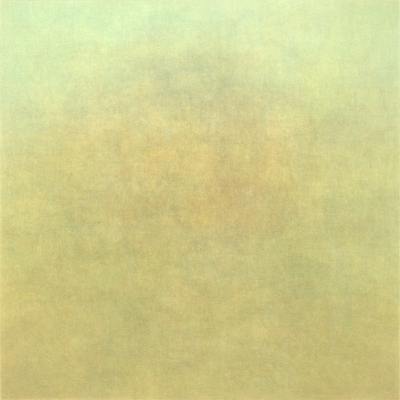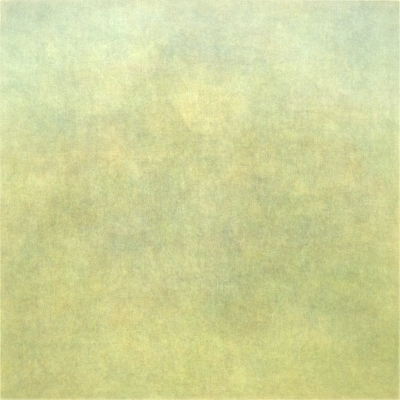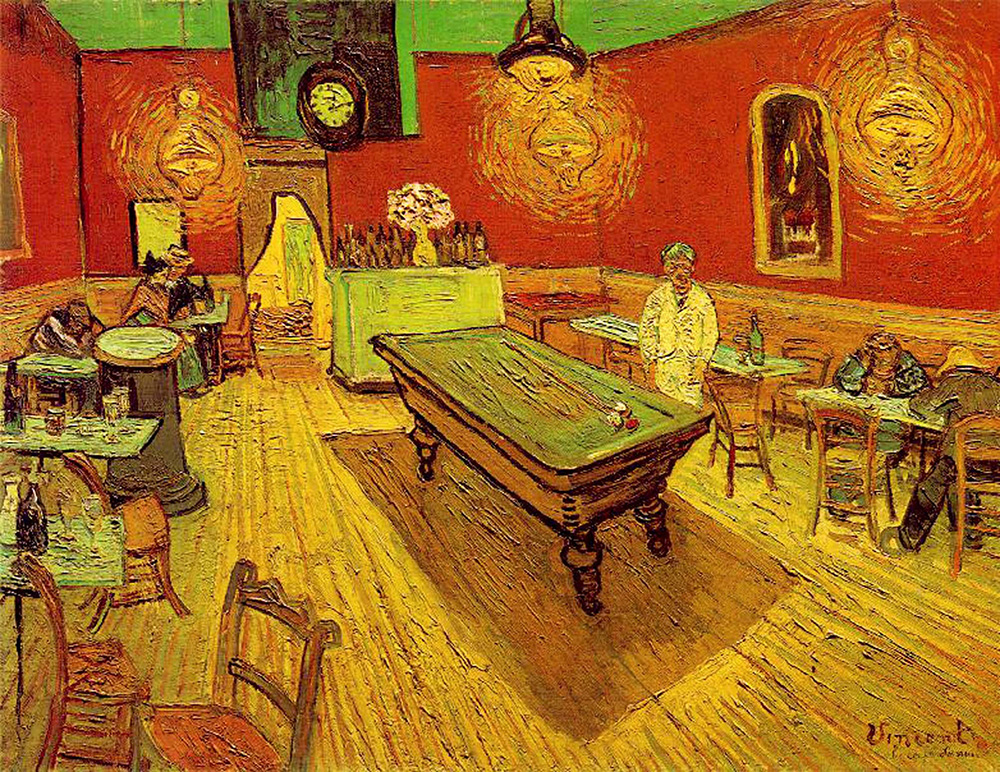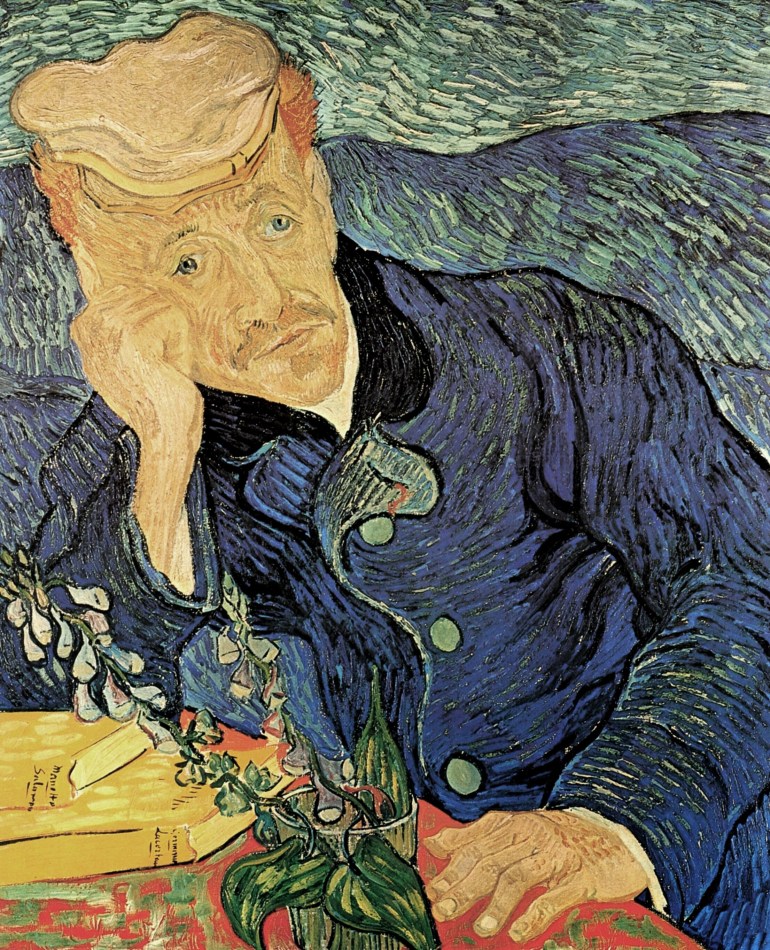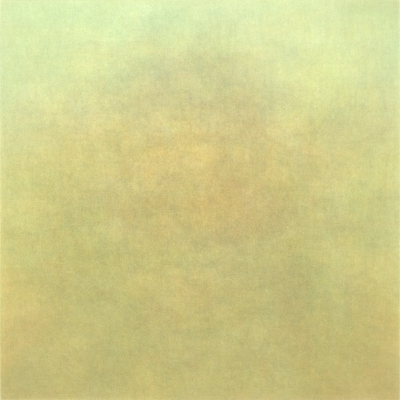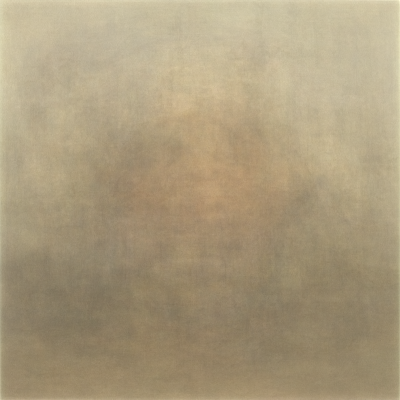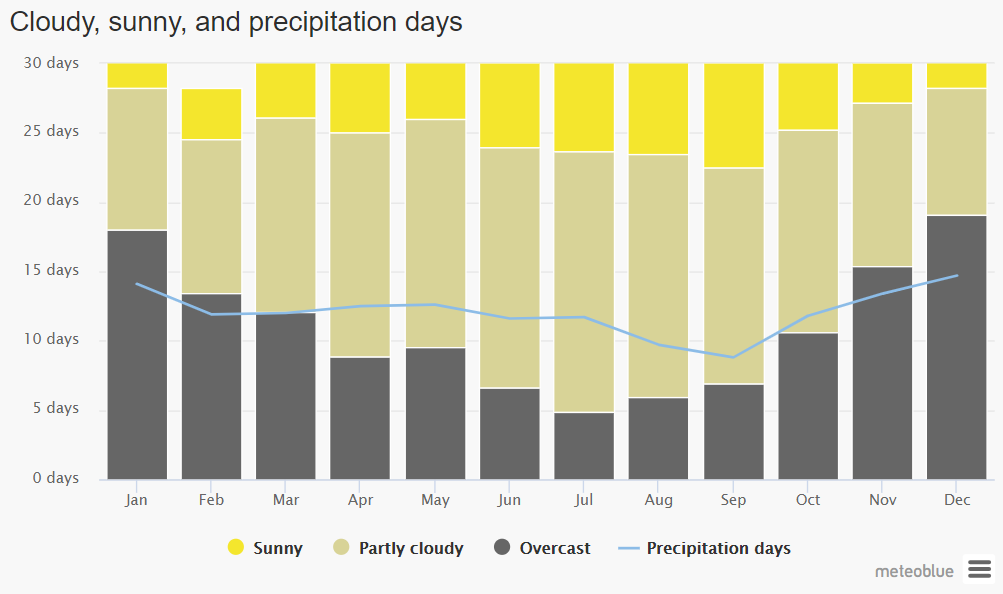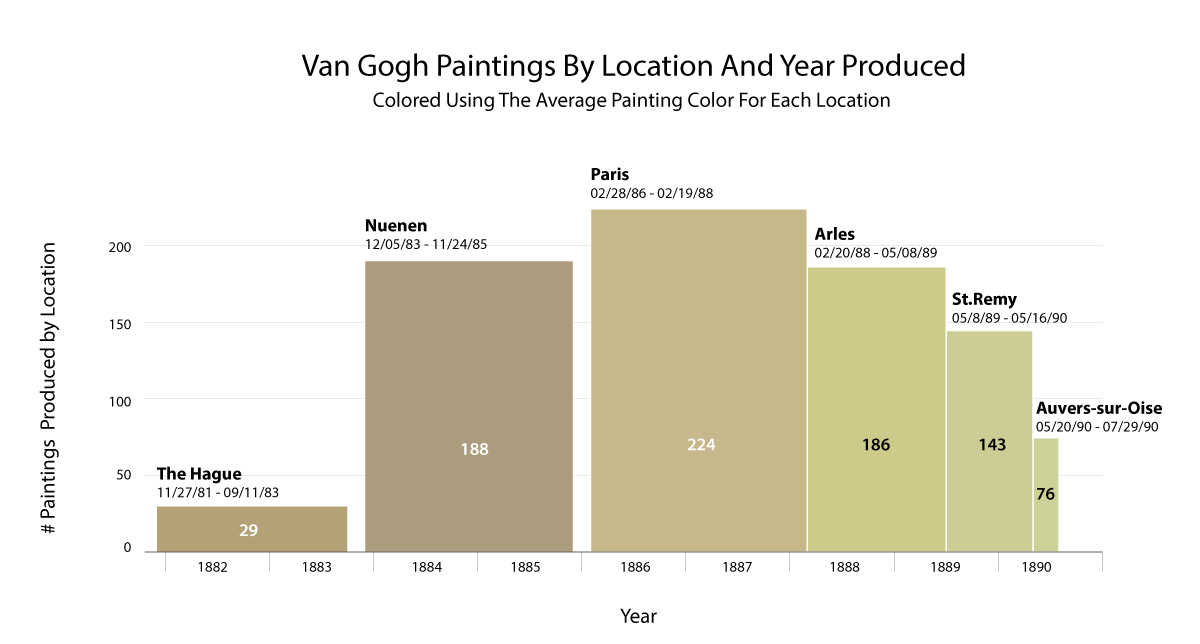When most people think of Van Gogh, the first color that comes to mind is a warm, radiant, golden yellow. Yellow sunflowers, yellow fields of grain, even the yellow moon in Starry Night.
But Van Gogh’s paintings did not start out that way. As late as 1885, roughly halfway through the short decade Van Gogh spent painting, he was still in his Dutch period, painting works like The Potato Eaters, which feature dark, muddled, grays, browns, and greens.
Vincent Van Gogh, The Potato Eaters, 1885
Curious about this shift from dark to light, we decided to use data visualization techniques to better isolate the moment of transition to a bright yellow color palette.
As a first step, we sorted every Van Gogh painting by year and then calculated the simple arithmetic average by dividing out the sum of pixels by the total number of paintings. In layman’s terms, we created the “average” Van Gogh painting for each year he was active. We were hopeful that this could pick up some of the subtleties in his shifting color palette over time. There were too few works to get a solid average in the first two years, so we shortened the range to 1882-1890.
1882
1885
1883
1886
1884
1887
1888
1889
1890
In looking at the series of images, there is an unmistakable shift towards a lighter yellow palette starting in 1888.
We are not first to notice this. There are two popular theories around why Van Gogh shifted his color palette.
We will briefly look at both theories below and then offer up our own.
Did Van Gogh Suffer From “Yellow Vision”?
One popular theory behind the shift in Van Gogh’s color choices is that he might have suffered from xanthopsia, or “yellow vision.” Xanthopsia is a “color vision deficiency in which there is a predominance of yellow in vision due to a yellowing of the optical media of the eye.” When caused by glaucoma, this can also include halos and flickering, which many think explains why Van Gogh depicts light as radiating outward, as in The Night Cafe (1888) and The Starry Night (1889).
Vincent Van Gogh, The Night Café, 1888
Vincent Van Gogh, The Starry Night, 1889
Others believe that Dr. Gachet, the physician who treated Van Gogh in his final months at Auvers-sur-Oise, may have treated Van Gogh’s seizure’s with digitalis extracted from the plant fox glove, which is also known to cause yellow-blue vision and halos as a side effect.
Vincent Van Gogh, Portrait of Dr. Gachet, 1890 (note the fox glove plant shown in the portrait)
Another frequently cited reason for the shift in Van Gogh’s color palette was his move to Paris in 1886. It is generally assumed that he was inspired by the bold use of color by the French Impressionists.
We were not convinced by the medical reasoning behind the shift in Van Gogh’s color palette and we could not think of any French Impressionists that painted with colors nearly as bold as Van Gogh, so we decided to take a look at some other possibilities.
Did Van Gogh Use More Yellow Because He Moved to a Sunnier Climate?
Van Gogh was a restless soul and moved around quite a bit. He also spent a lot of time painting outdoors, especially in his later years. As someone who famously struggled with mood swings, we thought location, and more importantly, weather patterns may have impacted his use of color.
To test this, we created composite images averaging every painting Van Gogh created from each of the major locations he worked from and compared them to weather patterns from those regions. We think the results are quite remarkable.
The Hague
The Hague
Arles
Arles
Nuenen
Nuenen
SAINT-REMY
SAINT-REMY
Paris
Paris
Auvers-sur-Oise
Auvers-sur-Oise
Look at the spike in sunshine in Arles as compared to all previous locations! We feel pretty confident that it was the warm weather and bright colors of southern France that influenced Van Gogh’s shift towards bolder colors, not “yellow vision” or exposure to the French Impressionists as previously thought.
Not only did Van Gogh literally see the world bathed in yellow sun while in Arles and Saint Remy, he was also able to get outside more often as there were literally more sunny days. I don’t think it is unreasonable to assume exposure to the sun and outdoors may also have lifted his mood, causing him to brighten his palette in response, as well.
Charting the average painting by location also brought some interesting things related to timing to our attention. To make these timing issues even clearer, we created the chart below. Each bar is colored using the average color for paintings created in that specific region. The chart then shows the order in which Van Gogh lived in each region and the total number of paintings produced there.
Note that from this chart we can very clearly see that Van Gogh’s palette shifted after, not during, his time spent with the French Impressionists. Let’s call that myth busted.
It is also clear from the chart that Van Gogh’s palette turned yellow years before he became a patient of Dr. Gachet at Auvers-sur-Oise. Second myth… also busted.
This leaves our theory of increased exposure to sunlight, which the data has shown to support. Of course correlation doesn’t necessarily imply causation, and we can’t say for sure that the weather caused Van Gogh’s palette to switch. But we feel it is a stronger hypothesis than the ones currently out there and Van Gogh certainly left us plenty of clues to support our belief that increased sun was his inspiration for using more yellow. Our favorite:
“How wonderful yellow is. It stands for the sun.” - Vincent Van Gogh
Vincent Van Gogh, Vase with 15 Sun Flowers. 1888
Conclusion
At Artnome, we are big believers that data and new analytical tools can and should be used to provide new context for important art and artists. In this case, we feel relatively confident that by using data visualization, we have ruled out the two most popular explanations for Van Gogh’s shift in color palette: first, illness/medication; and second, Impressionism. We have also used weather data and geo-data to propose a more reasonable theory behind the switch to a bright yellow palette: When Van Gogh moved to the south of France, he experienced a significant increase in sunny days. His world became dramatically brighter and more yellow; he simply painted what he saw (while adding his own artistic license).
This article would not be possible without the hard work and analysis of Artnome data scientist Kyle Waters. He has made an enormous contribution to Artnome in a short amount of time, and we are excited to continue working with him. In an upcoming article, he will go into more detail around how he calculated the average images for Van Gogh in detail.
Also, if you like this article, you may also enjoy our other nerdy art articles on:
As always, thanks for reading and for your support. Feedback is always welcome and you can contact us at jason@artnome.com

